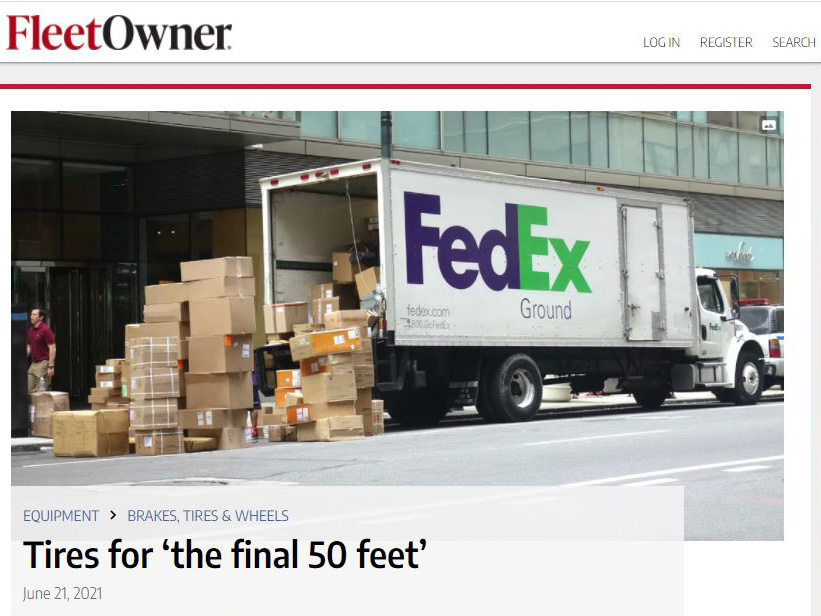
By Kevin Rohlwing
For as long as I can remember, the five most popular original equipment and replacement truck tire sizes have not changed. The 295/75R22.5 and 11R22.5 have commanded the top two spots dating back to the early 2000s. Together they represent over half of the original equipment market and almost half of truck tire replacements. Over the last few years, the 275/80R22.5 has occupied the third spot for original equipment, while the old 11R24.5 has been hanging onto the third position for replacement truck tires.
The 225/70R19.5 has occupied the No. 4 spot for original equipment and replacement truck tire shipments for a while, but 2020 saw a major shift in original equipment sizes. In 2019, the 225/70R19.5 represented 8.7% of the total original equipment market, or about 565,000 tires, good enough for fourth place. Just a year later, it represented 11.7% of the original equipment market, or about 526,000 units, and moved ahead of the 275/80R22.5 for first time. And while original equipment shipments, in general, were down 2 million tires, from 6.5 million to 4.5 million (almost 30%) last year, the 225/70R19.5 only dropped 7%.
A recent report by the University of Washington Supply Chain Transportation & Logistics Center estimated that 25-50% of transportation supply chain costs are driven by the last phase of delivery, or the “final 50 feet”. This pre-pandemic study followed a report by investment bank Morgan Stanley that estimated by 2022, Amazon’s U.S. package volume could be greater than either UPS or FedEx. Between the three, Morgan Stanley predicted their combined package volume would be almost 15 billion packages.
Judging by the Amazon boxes curbside on recycling night in my neighborhood and the number of deliveries I’m seeing on the weekends, the “final 50 feet” continues to be a growing part of the supply chain. The Class 4-5 vehicle has been the workhorse of the home/business delivery industry for years, with UPS and FedEx leading the way. Most of them run the 225/70R19.5 because it’s a small tire that carries a lot of weight, which makes it easy to design around for carrying packages.
The differences between a 19.5-in. truck tire and a light truck tire with the letters “LT” molded on the sidewall are significant. First and foremost, the 19.5-in. tire is governed by Occupational Safety and Health Administration Regulation 29 CFR 1910.177, so all training and inflation equipment requirements must be met. Some retailers see a 19.5-in. tire as a slightly bigger and heavier version of a light truck tire. It can be demounted and mounted on a standard tire machine, so they see no reason to treat it differently. This can be a fatal mistake.
From a construction standpoint, there are some minor differences between a 19.5 and 22.5-in. radial truck tire, but both have steel sidewall plies (which means both can experience a zipper rupture during inflation) and a retreadable casing. From the service perspective, 19.5-in. tires are more difficult to demount and mount because the short side of the drop center is on the disc side of the rim, which means the technician has to work around the disc to pry the beads over the flange. It can and does result in bead damage when bead lubricant is not applied correctly and combined with poor technique using tire irons. Truck tire changing machines may be the solution to bead damage problems on 19.5-in. tires but failing to apply bead lube can still contribute to improper procedures that lead to damaged beads.
The “final 50 feet” is going to become more important as consumers embrace the convenience of e-commerce. With rising gas prices, increased tolls, and proposed mileage taxes, more and more people will just shop from their phone or computer and let someone else do the driving. It may not be the best news for the automobile manufacturers or brick and mortar retail, but the 19.5-in. truck tire market is positioned to play a larger role in transportation when almost everything is delivered to the consumer’s front door.
As the size of the market continues to grow, more tire manufacturers will want to get in the 19.5-in. game. Increased competition will drive innovation in 19.5-in. tires like it has with 22.5 tires, so the overall quality and performance is expected to improve if the trend continues. While ecommerce is changing supply chain logistics, recent strong new-vehicle sales in Class 4-5 indicate that delivery trucks are still part of the solution to the “final 50 feet,” so demand for tires like the 225/70R19.5 is expected to increase. All of those original equipment shipments last year are going to have a direct impact on replacement sales this year and next.
If the new Class 4-5 truck sales remain strong, the 19.5-in. truck tire market is about to shift, so fleets that were never concerned about tire cost per mile could be in for some expensive lessons. There are wide gaps in technology and price for a 225/70R19.5, which means low prices can end up having high costs when they don’t deliver the mileage or retreadability.